

Contents
- Summary of the Medical Imaging Compensation Review ……………………………………………………………………………………………………………………………………………………….
- Other Medical Imaging Compensation Data ……………………………………………………………………………………………………………………………………………………….
- RSG Health Services Medical Imaging Wage Data ……………………………………………………………………………………………………………………………………………………….
- Placements by Gender ……………………………………………………………………………………………………………………………………………………….
- Offers Made by Years of Experience ……………………………………………………………………………………………………………………………………………………….
- Wage Data, ARRT Specialties ……………………………………………………………………………………………………………………………………………………….
- Most Requested ARRT Specialties ……………………………………………………………………………………………………………………………………………………….
- Wage Data, ARDMS Specialties ……………………………………………………………………………………………………………………………………………………….
- Most Requested ARDMS Specialties ……………………………………………………………………………………………………………………………………………………….
- Bureau of Labor Wage Data ……………………………………………………………………………………………………………………………………………………….
- Regional Compensation Differences ……………………………………………………………………………………………………………………………………………………….
- Relocation & Bonus Incentives ……………………………………………………………………………………………………………………………………………………….
- Relocation & Bonus Incentives, cont. ……………………………………………………………………………………………………………………………………………………….
- Repayment Agreements ……………………………………………………………………………………………………………………………………………………….
- Medical Imaging Travel Sector ……………………………………………………………………………………………………………………………………………………….
- Work/Life Balance in Medical Imaging ……………………………………………………………………………………………………………………………………………………….
- Economic Conditions that Affect Medical Imaging Jobs ……………………………………………………………………………………………………………………………………………………….
- About RSG Health Services ……………………………………………………………………………………………………………………………………………………….
Summary of the Medical Imaging Compensation Review
The 2025 Medical Imaging Compensation Review is based on the total number of full-time (permanent) job requisitions acquired by RSG Health Services between January 1, 2024, and December 31, 2024. The compiled compensation data discussed in this review are ARRT modalities including Radiography, Computed Tomography, Magnetic Resonance Imaging, Mammography, Nuclear Medicine, and Interventional Radiology. The review also includes common ARDMS modalities such as Ultrasound, Vascular, and Echocardiography. Similar to our previous reviews, the majority (89%) of the job searches represented in this review consist of hospital-based positions, with the remaining 11% being outpatient imaging jobs.
The wages shown in this report reflect the lowest, average (mean) and highest wage offered for each specialty group when combining all data provided to us through our human resources partners when collecting search criteria. The data does not include shift differential, bonuses, or overtime, only the base wage that was offered. Why is this important? Many of the third-party compensation surveys available to the public use survey platforms to collect data directly from providers. Therefore, their data might include pay provided by contract workers (travelers), which can be much different. Provider surveys might also include overtime, bonuses, holiday pay and shift differential that may or may not be consistent. The goal of this compensation review is to provide data on full-time jobs and the base wages only. As in our previous compensation reviews, outliers were also taken into consideration when compiling the data and removed when calculating the averages.
New hire appropriations such as relocation packages and sign-on bonuses remained consistent last year, as many employers still found it necessary to offer these incentives to entice job seekers to relocate to their respective service areas. While this has been a traditional practice for at least two decades, we observed considerable increases in the amounts being offered over the past few years.
We are excited to see that wages increased in many areas of the U.S. again for a fourth consecutive year. While we have been tracking wage data for imaging providers for over 20 years, we might not have predicted that staff technologists would be offered upwards of $70.00 per hour. While some organizations have been slow to increase wages, others have found that raising wages for their full-time staff far outweighs staffing their departments with contractors.
While this report is largely about compensation, we do like to offer insight on the temperament of the medical imaging field, as we know there are many other factors that go into accepting a job. Compensation aside, another factor we often hear when speaking with imaging providers is finding a better work schedule. While there might be many jobs to choose from, the vast majority assigned to us are off-shifts, nights, weekends, etc. As of this writing, it seems many travelers are coming off the road and reentering the full-time (permanent) job market. Many job seekers are finding that the coveted day shift schedule, outpatient openings, and similar roles that do not require being on-call, are just hard to find. We believe many of these roles were offered to the staff who remained behind during the pandemic while others decided to join the travel sector.
While the travel sector might be less lucrative than it was just a couple of years ago, it can still be an option to those who are not tethered to responsibilities at home. Young children, pets, and other obligations that require daily attention back at home prevent the majority of imaging providers from hitting the road. Additionally, with the increase of short-term rental costs, lowering of contract rates and other factors, some are finding that a permanent job is just as suitable now that wages have increased over the past few years.
In summary, as of the writing of this review, the job market for medical imaging providers seems strong. As a permanent placement agency, we believe the need for full-time staff is still at an all-time high. Our records indicate that many of our clients have increased wages yet again in 2024. This is great news for medical imaging providers who are entering the field, as well as others who are looking to come off the road. There are many benefits to both full-time and contract jobs, so seeing wages increase by more than 10% in some modalities is very positive for our industry.
We poll imaging providers frequently to check the pulse of our industry, and it seems some imaging providers feel as if the industry is going in the wrong direction. From our perspective, there is still a lot of animosity towards other clinical professions that are perceived as being paid more, and that medical imaging has somewhat been disrespected. While this is just a perception from our team, all you have to do is ask a technologist how satisfied they are with their job or go on one of the numerous Facebook or LinkedIn groups to view the many comments about the industry. It also seems that many believe being paid a higher wage will all of the sudden make them happy with their job. Clearly, being paid more does not solve bad management, excessive on-call, or a hostile work environment, so we tend to push back a bit on this topic. Sure, we want someone to be paid a competitive wage because we believe it is in everyone’s best interest. A healthcare provider is less likely to leave a job we’ve helped them obtain if they are making top dollar, and that indeed does benefit all parties involved. However, it will not solve the overall problem of being understaffed and underappreciated. Now they are just paid a bit more but are still unhappy with their working conditions. Here is an example of a message one of our recruiters received about pay, and it defines the attitude of many imaging providers today.
“We learned over Covid that hospitals consider us expendable until we are needed. We are an expense to them, not a family. In the beginning, shifts were canceled. We struggled to pay bills and find hours to fill our schedules. We were forced to take vacation days on non-vacations (during a time in which we could not travel) in order to pay our rent. Several months later, we were told we were important. Come back to us. The damage was done. We knew our value to the facilities was low and they were not willing to overlook their bottom line in order to keep our needs met.
They showed us they did not have the forethought to prepare appropriately with PPE storage and emergency planning to keep us healthy. There was a mass exodus in our field. We were then expected to work at 30-50% staffing levels. We were assigned mandatory OT. It was our “duty” as healthcare workers to make sure America was taken care of. The companies profited from our hard work, as we became increasingly exhausted.
We are in a field with no patient to tech ratios. We are expected to do more with less every day. While work life balance is important, we are at the stage where it’s our turn to fight back. Show us the money. Compensate us for ruining our mental health for years. Compensate us for working us so hard in the saddest, most difficult times. Compensate us now that you realize that we are truly not expendable, and you cannot do more with less.
It’s our turn to push back against the $3M plus CEOs that watch us risk our safety each day with aggressive patients. Every year there are more administration and management positions created and less true understanding of clinical outcomes and how important financial safety and security is among healthcare workers.
We now know how little value hospital systems place on us. We know the hospitals will not protect us. We have to safeguard ourselves and push back against their bottom line to ensure one less stress in our lives.”
This is just one of many emails and comments we review as recruiters. As a result of the dissatisfaction by many imaging providers in our industry, we really try to encourage the ones we represent to ask for a team interview when going through the job interview process. Meaning, after speaking with Human Resources and the department manager, ask them to set up a call with several of the team members they will be working with. We do not see this happening nearly enough and many people end up back in the same situation they came from. During an interview, some providers are just sold on the good things being offered but they never speak to the staff about the daily workflow, the support they receive from management, and internal culture. You might be surprised by what a team of technologists will say in an interview if you ask.
Other Medical Imaging Compensation (ASRT)
The American Society of Radiologic Technologists (ASRT) indicated, all major disciplines across medical imaging have shown compensation increases over the last two years, according to their August 2024 survey. Here are the increases in the common imaging modalities from 2022 to 2024, according to the ASRT report.
- Nuclear Medicine Technologists – Up 20.2% from $88,576 to $106,475
- Vascular Interventional Technologist – Up 13.6% from $83,934 to $95,317
- Sonographers – Up 13.2% from $82,368 to $93,237
- MRI Technologists – Up 12.5% from $82,395 to $92,729
- CT Technologists – Up 12.3% from $78,159 to $87,785
- Radiologic Technologists – Up 12.3% from $65,246 to $73,274
- Mammography Technologists – Up 11.5% increase from $79,323 to $88,468
Again, this is a technologist survey and might contain shift differential, overtime, holiday pay, etc. Alternatively, our report represents only the base starting wage being offered. One more observation from the ASRT report. They note that compensation can vary greatly by region. We mention this every year in our compensation review as well, but it should be noted that the ASRT indicates California has the highest pay rates for X-Ray Technologists with an average annual compensation of $125,843 ($60.50/hr). In 2024, the average salary for a Radiologic Technologist in the United States was $86,484 ($41.58), according to the ASRT. This is a 12.3% increase from 2022. For more information, visit the ASRT website.
RSG Health Services, Medical Imaging Wage Data
As noted in all our compensation reviews, all employers we work for calculate wages based on years of experience. See this short video on calculating your wage. This excludes school, clinical rotations and other healthcare experiences that are unrelated to medical imaging. There seems to be very little deviation from this practice, and wages can vary widely throughout the country. Obtaining higher education and additional certifications usually have a minimal impact on the wage being offered, even if the provider is working in multiple areas of imaging. Exceptions to this might be for management roles where it is commonly requested that directors have a master’s degree, CRA certification, or both. However, in a competitive job situation, more credentials can make you more valuable than the competing candidates. We would like to see imaging providers be paid “premium pay” based on the number of certifications they hold, but that is still yet to catch on as a common practice. Honestly, we believe it could make a significant impact on organizations who need to hire technologists who can cover multiple service lines. We have developed a Compensation Checklist for facilities who are interested in this concept. It is foolproof, justifiable, and eliminates the grey areas of why a new hire might be paid more, even if they have less years of experience in the profession as a current employee.
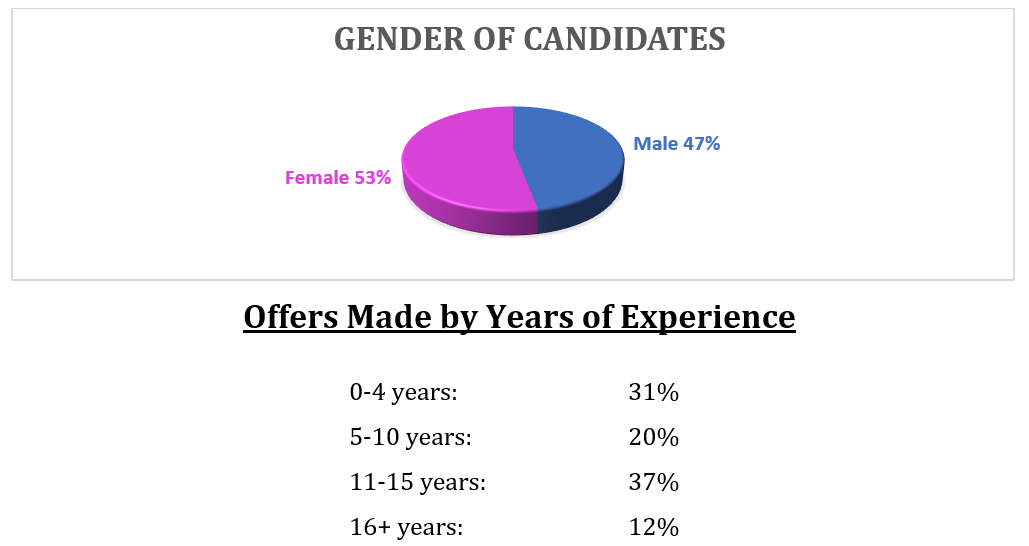
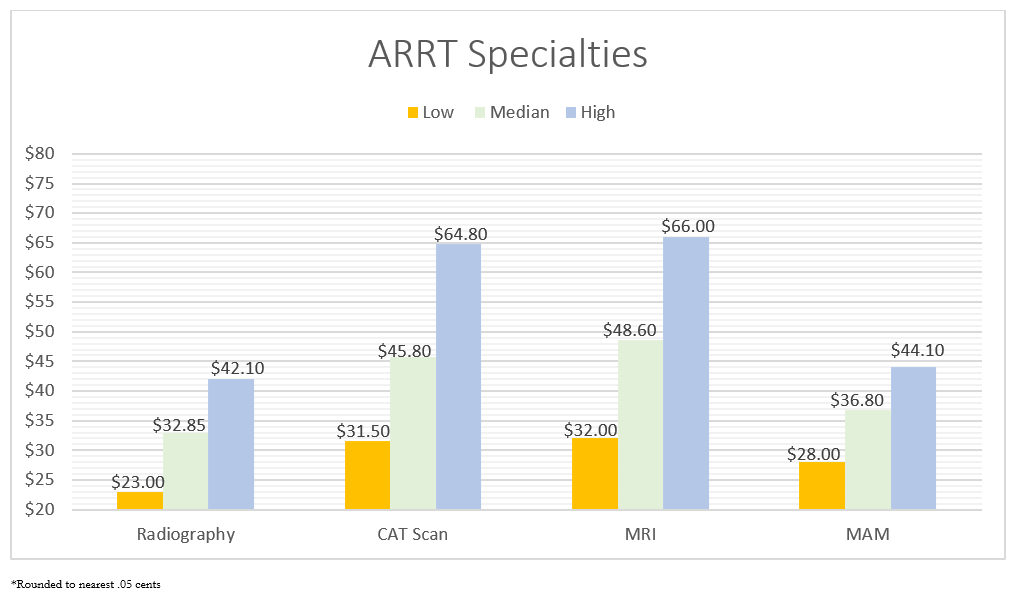
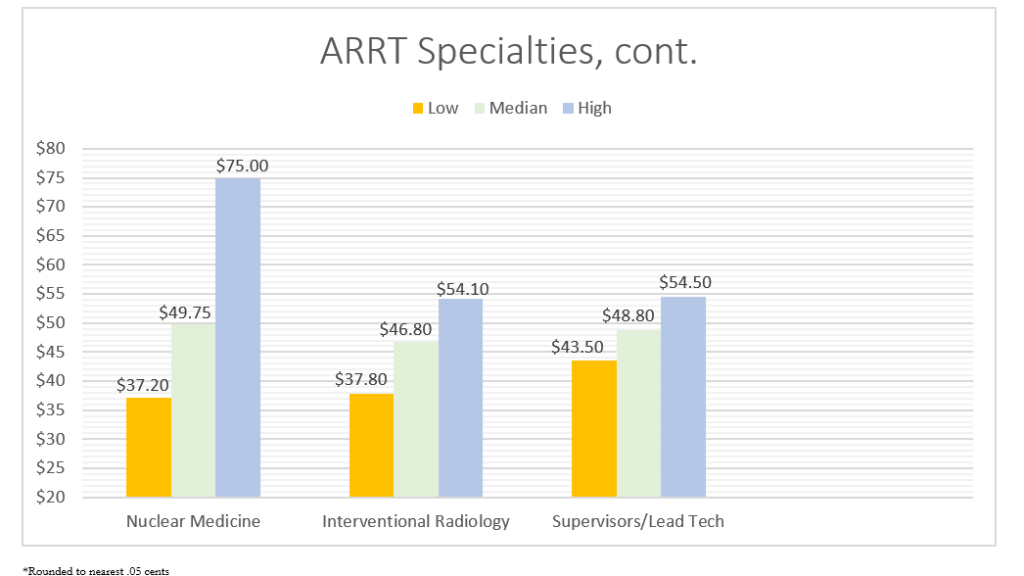
In 2024, for a second consecutive year, we had the most requests to recruit CT Technologists and Radiologic Technologists. When reviewing these pay rates, it is important to understand that the highest rates are generally offered to senior level technologists with twenty or more years of experience, and the low rate generally represents a technologist who is new to the field of medical imaging. Here is a breakdown of the most requested ARRT searches by our clients.

Notably, 56% of the recruiting requests were for Computed Tomography (CT), Radiography (R). Magnetic Resonance Imaging (MR) Technologists were right up there at 22%. This has been pretty consistent over the past 4-years, and we do not anticipate the demand in these three modalities to change in 2025.
Ultrasound Sonography Wages
Surprisingly, the number of job requisitions we have received to recruit sonographers has been down over the past three years. When speaking to sonographers across the country, there seems to be a bit of concern about this. This might be largely related to the number of ultrasound schools in a certain city or state. For example, in Ohio, there are fourteen ultrasound schools that produce students annually. This seems to have saturated the state and ultrasound jobs can be difficult to find in some areas of the state. The same holds true in Florida where they have twenty-one CAAHEP accredited ultrasound schools offering educational training in sonography.
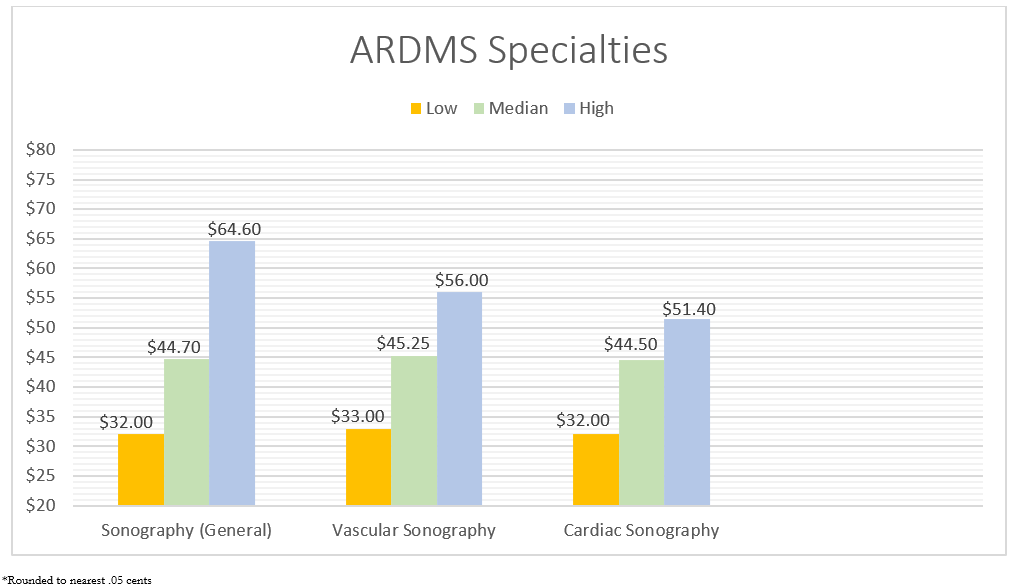
Once again, when reviewing these pay rates, it is important to understand that the highest rates are generally offered to senior level sonographers with twenty or more years of experience, and the low rate generally represents a sonographer who is new to the profession. Here is a breakdown of the most requested ARDMS searches by our clients. Those who practice general ultrasound are usually the most in demand. This has been true for as long as we have been tracking compensation data. Sonographers who have the flexibility to perform procedures such as abdomen, pelvic, Ob/Gyn, breast, basic vascular studies, and small parts will typically have more options for employment than someone who specializes in a single area of sonography. While we understand that many sonographers like to specialize in areas such as vascular, echocardiography, and MFM, from the pure perspective of having options for employment, these jobs are not nearly as abundant.
Generally speaking, when it comes to working for a small hospital, the more diverse a sonographer is, the better. When we receive a request to recruit providers who specialize in vascular or cardiac ultrasound, it is usually for a clinic or very large medical center with designated labs for echocardiography and vascular ultrasound. This makes up just a small percentage of our client base.
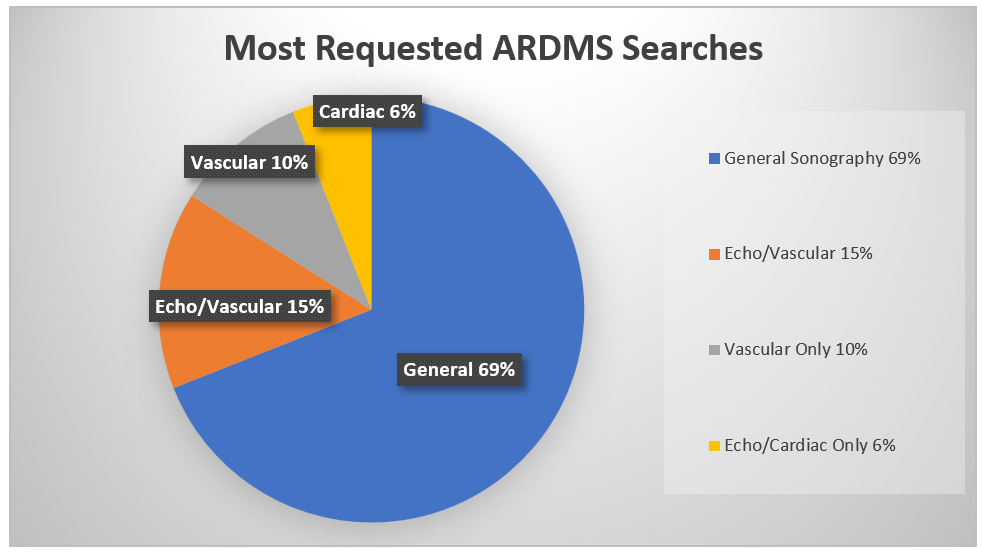
Medical Imaging Compensation, Bureau of Labor Statistics (BLS)
The Bureau of Labor Statistics (BLS) does not provide data for all imaging modalities, but it does appear they have updated their website and provided revisions to some healthcare specialties. The data below reflects the most recent data from the BLS website, May 2023.
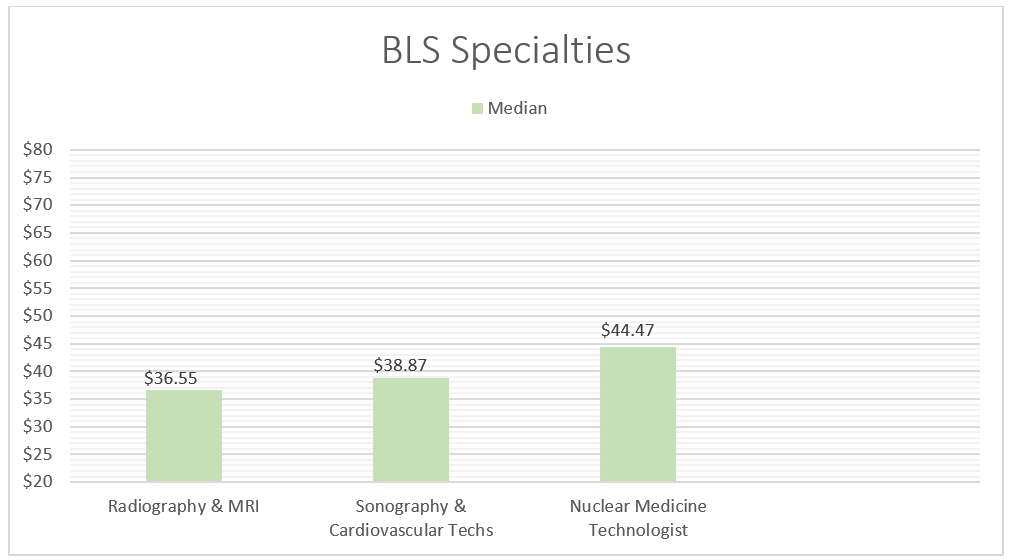
The BLS seems to have lumped Rad Tech wages into the same category as MRI Techs, and they did not differentiate general ultrasound from cardiac ultrasound. To us, it is not clear data, but it can be used as just one more benchmark when assessing wages. This is the exact text from the BLS as it relates to a Radiologic Technologist job description; “What Radiologic and MRI Technologists Do? Radiologic technologists perform diagnostic imaging examinations on patients. MRI technologists operate magnetic resonance imaging (MRI) scanners to create diagnostic images.”. Based on this, we believe they are referring to wages for only Radiologic Technologists, but it is a bit unclear since the data is lumped together.
Regional Differences in Medical Imaging Compensation
RSG Health Services does not provide specific compensation data from individual cities and states. While we understand this specific information might be helpful, there are certain states that produce limited data for us. For example, the state of Wyoming has approximately thirty-three hospitals. By comparison, Florida has just over three hundred hospitals. In 2024, we worked for many clients who are largely concentrated in the south such as Texas, Florida, North Carolina, South Carolina, Georgia, Arizona, New Mexico, Missouri, etc. Therefore, you can understand how this compensation review can be heavily weighted to represent some regions over others. We also have a strong client base in California, Ohio, and Colorado. If you work in states like California, New York, Virginia, and Washington State, wages can be much higher. However, you should also recognize that everything from real estate, property taxes, state income taxes, gasoline, etc., can also be substantially more expensive in these areas as well. While it is true that no one likes to take a reduction in pay when they change jobs, it is important to consider your standard of living when making a move, not necessarily only what’s on your W-2. It is very possible to have a better standard of living in another state that pays you less than what you might currently be making. For example, if your mortgage payment drops from $5,000 per month to $2,500 per month when you move from California to Missouri, that’s a $30,000 savings. This does not include many other factors like reduced taxes, fuel, and other necessities. So, making $60 per hour in California means you can likely have the same standard of living making $14 per hour less in Missouri, in this basic example.
The Pacific Region is by far the highest paying region in the U.S., in some cases paying up to 100% more than some areas of the Southeast. For example, wages in the bay area of Northern California for a CAT Scan Tech might reach as high as $80 per hour, whereas that same job in Shreveport, LA might offer $40 per hour. Wages in the Rocky Mountain, Southwest, and Midwest regions seem to be mostly comparable. The Northeast region can be somewhat hit or miss, with areas like Washington, D.C. paying higher than areas such as Philadelphia, PA. Many states have disparities in pay. Another example of this might be Jackson, WY versus Casper, WY, and Seattle, WA versus Yakima, WA. Same state, but considerably different pay scale. While these are just a couple of examples, what a provider is paid usually goes hand in hand with the cost of living in that respective area. As we have pointed out many times in our reviews, no one should expect to make San Francisco wages in Pensacola, FL.
According to the Bureau of Labor Statistics’ Occupational Outlook Handbook (OOH), there are currently over 270,000 Radiologic Technologists in the United States. They do not disclose if these numbers include non-certified technicians, but this is just one more metric that can be used to determine pay. The BLS does project growth of 6% for the profession, which is faster than the overall average, over the next 10 years.
While some of the data on the BLS website might be somewhat ambiguous to us, it is still relevant information to our industry. There is a lot of good information on the BLS website as it relates to employment for Radiologic Technologists, so we encourage you to review their website at www.bls.org for more comprehensive information.
Relocation, Bonuses & Other Incentives

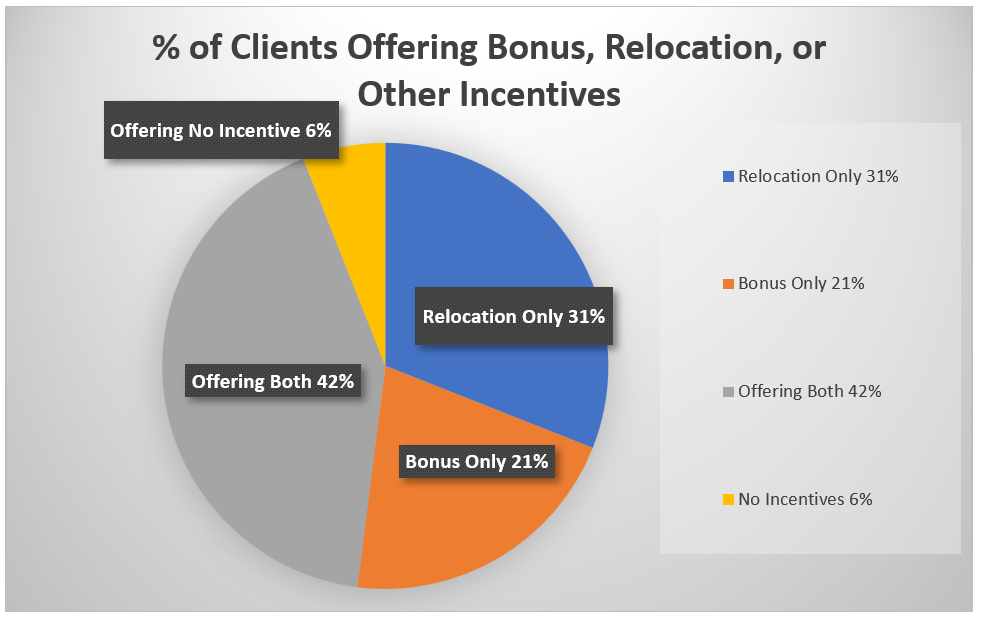
Sign on Bonuses may have lost the luster they once had, but they are still a big part of many employment packages. It is common for many organizations to offer upwards of $10,000 to $20,000 as a “sign-on bonus”. However, we find that most are not Sign-on Bonuses at all and are actually a Retention Bonuses. Not to discount the offering. After all, a $20,000 bonus does break down to $9.62/hr when broken down hourly over a twelve month period. However, most so called “Sign-on Bonuses” are not actually paid when a person starts or “signs on.” They are usually paid out in installments over a period of a few months. By accepting these payouts, it will require the new hire to stay with the employer for a specified period or they will have to repay the incentive. This might also include offerings of a relocation package as well. It’s important to discuss these things with your HR professional at the facility to determine what your obligation will be to receive these funds. To be clear, these available payments are voluntary and do not have to be accepted. If they are not accepted, then there is no contract that needs to be signed, and you can leave the job at any time without the fear of having to repay a sum of money.
Regarding these incentives, 94% of the clients we work for offer some sort of relocation or bonus incentive to assist candidates with relocation and other expenses when it comes to making a move to their communities. Candidates usually expect some sort of relocation/bonus assistance to be offered if you are pursuing them and asking them to leave their current employer. If it is not offered, then they will usually move on to the competition who does offer it. While there is no rhyme or reason for the amounts being offered, it is expected unless the person is already living in the employers’ service area.
Relocation can sometimes be more negotiable than the pay itself due to the ol’ “internal equity” justification that employers give us on a regular basis. Essentially, they are implying they cannot pay a new hire more than an existing employee because that might upset someone in the department, should they find out. Relocation is a bit more self-explanatory. Bids can be obtained from moving companies and negotiated accordingly, if needed. Bonuses are discretionary, and some employers are more willing to negotiate this rather than the actual wage. Many times, bonuses are just a way for the employer to sweeten the job offer and provide the new hire with additional monetary resources that might be needed when making a move.
Repayment Agreements in Medical Imaging
As a standard practice, repayment agreements are usually required by an employer in return for receiving relocation assistance and/or bonuses. These agreements simply allow the employer to legally recover these discretionary payments through payroll deductions or other means in the event a person leaves before fulfilling their agreed upon employment contract. In some cases, employers do prorate the amount and will give credit for the actual time worked under their contract should the employee leave before fulfilling their agreement upon term. While this varies from employer to employer, most agreements are usually for one or two years. Again, this usually applies to both relocation assistance and bonuses. Employees can leave for any reason, at any time, otherwise. United States labor law also allows “at-will employment”, meaning an employer has the legal right to dismiss an employee for any reason, and without warning, if the reason is not illegal.
Like everything else, relocation has become more expensive. Inflation, due to supply chain issues and the Feds decision to raise interest rates eleven times between March 2022 and July 2023, did not help matters. These financial issues directly affect an employer’s outcomes when trying to recruit providers who live outside of their service area. However, as of the writing of this review, it appears the Fed will sit tight on rates as it continues to review inflation numbers in 2025. By all measures, we see this as good news for employers and job seekers alike. The point being, new hires will incur expenses for moving household items, deposits for rent, utilities, and many other expenses when moving to a new community. If you are the one courting them and asking them to leave their current job and home, you should be assisting them with the matter.
Medical Imaging Travel Technologists/Travel Jobs
While our company specializes in providing recruitment services, not temporary staffing, our team speaks to imaging providers in the travel sector daily. Since late 2020, the travel sector has been a gold mine for many imaging providers who were able to perform contract work. However, it does appear that contract assignments have cooled off quite a bit.
In a poll we conducted on LinkedIn, we were provided feedback on the status of the travel sector from 460 contract workers who are still traveling. We simply wanted to know if the contract market is currently as lucrative as it was just a year ago. The overwhelming reply was “no”. Some providers seem to feel the hassle of being on the road for months at a time is no longer worth the increase in compensation. However, becoming a travel technologist can still be a good option for those who can be away from home for months at a time.
Work/Life Balance in Medical Imaging
Sure, wages have increased over the past three years, so why are so many radiology departments still struggling to recruit staff? To us, the main reason is quite simple. We believe it is a lack of employers who can offer work/life balance. While compensation is always one of the first questions that comes up when we screen someone for a job, that really should a bit later in the conversation. Why, you ask? Well, if you are being verbally abused by the radiologist(s), are on-call every other week, are severely short staffed, your boss is clueless, and you have not had a vacation in over a year, does making an extra $5 per hour solve these problems? Chances are the answer is no. It might keep someone around for a little while longer, but they are still going to be in the same working environment. Making a competitive wage for your area, having a balanced schedule and minimal on-call requirements might be a better situation for some people. To us, money is just one factor when considering a job. If you are interviewing for a job, ask about work/life balance instead of focusing on money. Ask to speak with a few of the peers you will be working with. Do your due diligence before accepting a job just because it pays you a few more dollars. We see medical imaging providers leave a job for less pay all the time, and it is usually because they have no support, are overworked, and unappreciated. In a recent article we wrote titled, “Work/Life Balance for the Win”, it was clear that quality work, time off, and a good schedule are the most important factors for most providers when seeking new employment.
Economic Conditions Affecting Medical Imaging Jobs
As of this writing, the U.S. labor market has been a source of strength in the economy. The annual inflation rate for the United States was 2.9% for the 12 months ending December 2024, according to U.S. Labor Department data published on January 15, 2025. With housing costs higher than they have ever been and the cost of a mortgage being close to 7%, many are just reluctant to make a move, even if it’s for a better, higher paying job. What most people do not seem to realize is the 30 Year Mortgage Rate in the United States averaged 7.73% from 1971 until 2024, reaching an all-time high of 18.63% in October of 1981, and a record low of 2.65% in January of 2021. So historically, rates are currently somewhat normal. As of February 6, 2025, the average rate for a 30-year fixed mortgage is 6.89%, while the 15-year fixed mortgage averaged 6.05%, according to Freddie Mac. Many forecasts predict mortgage rates will decrease gradually through 2025. However, there is no guarantee of this ever happening, so don’t let a better opportunity pass you by waiting on the Fed. Yes, the economy might make it more difficult to change jobs, but it can be done. Wages are still on the rise, there are plenty of available jobs, and this means many healthcare providers who have weathered the storm might now have opportunities that were not available to them just a few years ago. Sometimes those who are reluctant to change jobs due to fear or improper planning miss out on great opportunities due to short-term conditions.
About RSG Health Services
RSG Health Services is a medical imaging recruiting firm focused on working with healthcare professionals in the radiology sector. At RSG Health Services we believe specialization sets our organization apart from the hundreds of other firms that operate in the same healthcare space. We hope the information provided in this compensation review is helpful and informative.


12 comments
Boyarka-inform.com
I used to be suggested ths blog by way of myy cousin. I am no longer certain whether
this submit is written via him as no one else know such cerain about my
difficulty. You are amazing! Thank you! http://Boyarka-inform.com/
Betty Gail McCay
Thank you for this information! It was very informative for our profession.
Christy
Dale,
Thanks for sending me this. We spoke last year about fair compensation and what kind of rate I should be looking for in my area. It definitely opened my eyes as to what I should be asking for with my credentials and years of service. I appreciate all the information and work that is put into this article!!
Yesenia Salazar
Very well constructed and easy to understand. Thank you for taking the time to organize this.
Dr Noshaba Rafiq
Thank you for sharing this article. It is well-structured, informative, and presents the topic clearly. Your thorough research and attention to detail are evident, making the content both engaging and insightful. The arguments are well-supported with relevant examples, adding credibility to your points.
Overall, this is a strong and well-written piece. I appreciate your effort and look forward to reading more of your work! Keep up the great work!
Dee Philipp
Dale, as usual, your assessment is spot on. I have just left my Director position in a rural area to move back home for a lesser position with less pay but better work life balance. Rural facilities must band together to secure some kind of state support to remain competitive and sustainable. I’d been on call 7 on 7 off for 7 years. Administration does not recognize that although all our techs are multi modality, we can only care for one patient at a time. They argue that the field of dreams staffing by staffing for the maximum operating hours per modality will not be beneficial, I completely disagree and had seen it play out! You must staff to include coverage for the accrued PTO and contingent illnesses. Short staffing leads to shorter staffing as our immune systems get depleted and burnout leads to losses. I am very thankful that BLS has come up. Flexible scheduling and job sharing amongst PRN’s works! Again thank you for the continued research and support of our profession!
Dee Philipp, MBA, MSRS, RT(R)(M)(CT)(S)
Krzysztof
Dale,
thank you so much for the detailed and comprehensive info.
A. Chesnutt
So if you are being paid on the low end of the wage, how do you approach your manager with this information and ask for a raise?
Dale Hannegan
Here you go > https://radsciences.com/the-right-way-to-negotiate-pay/
Elliott Taylor
Work/Life balance – the absolute main reason I left imaging last year. Thanks for sharing this.
Linda Spraggins
Very informative and accurate article.
Daryl
Very good info. Thank you